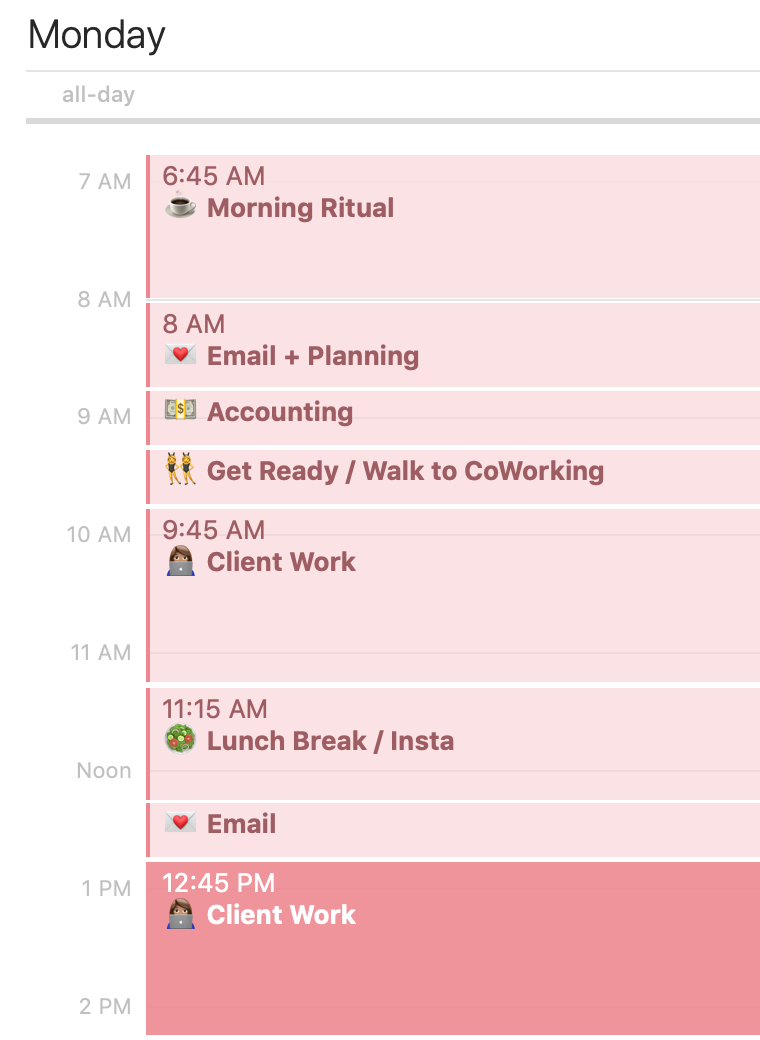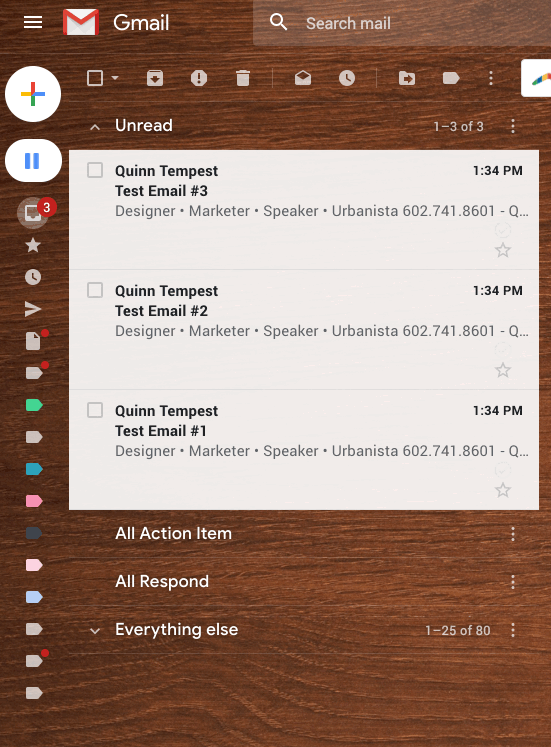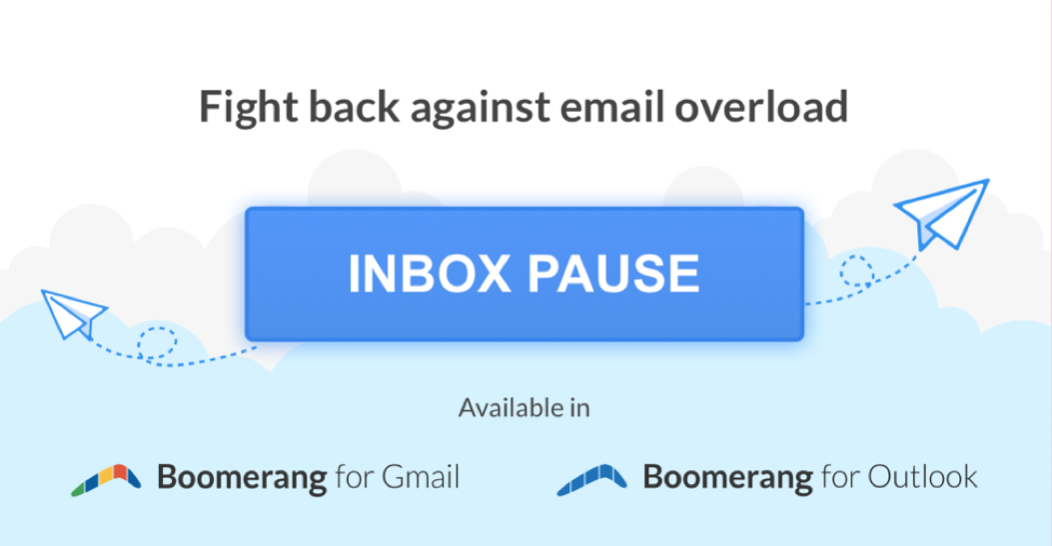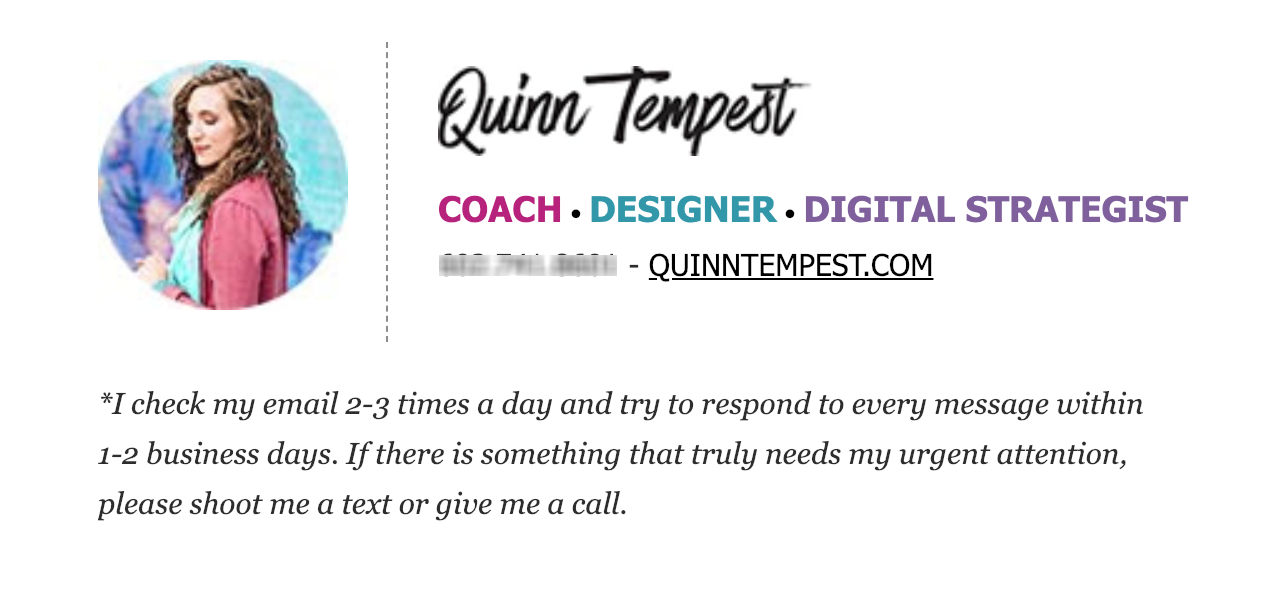5 Boundaries Every (Sane and Balanced) Entrepreneur Should Set
Until we learn to set boundaries for ourselves as entrepreneurs, we’re going to keep having our days prioritized for us by other people and projects.

As an entrepreneur, you have the power to create a job and a life that excites you, fulfills you, and allows you to express your deepest purpose.
In fact, that’s probably why you became an entrepreneur in the first place!
Here’s the thing: success and balance do not have to be mutually exclusive. You have the right to live a creative, inspired, and balanced life while running a successful, impactful business. It doesn’t have to be one or the other.
In order to achieve that kind of balance, setting boundaries is key.
How I Discovered the Importance of Boundaries (By Not Having Any)
Boundaries are extremely important to me personally because for so long, I seemingly had no idea what a boundary even was – just ask my therapist! At my first job out of college, I worked so long and so hard that I burnt out.
I landed myself in the hospital for 4 days and even that didn’t wake me up. I went back to work soon after (jumping right from part-time to full-time) and I spent months running on the fumes, staying out late at work functions, working weekends, and answering client calls at any hour.
I finally got to a place where I didn’t know where my job ended and I began.
I had lost myself.
Since then, I have become a boundary queen! I’ve looked at the reasons I didn’t have them in the first place, and created structures that help keep me sane and balanced.
I suspect I’m not the only one who has ever felt the way I did many years ago – frazzled, pulled in too many directions, and lost. Until we learn to set boundaries for ourselves as entrepreneurs, we’re going to keep having our days prioritized for us by other people and projects.
Here are just 5 simple strategies that you can start with and examples of how I’ve built these boundaries into my day-to-day life….

1. Establish ‘office’ hours
One of the clearest — and most important — boundaries that you can set is to establish office hours for yourself, first and foremost.
What time of day will you work, and on which days?
Having an intention in place is the first step to keeping your work and personal lives from blending together mindlessly.
And look – I get it – you probably got into business because you wanted your life and work to be more integrated. But integrated is much different than blended. Integrated is intentional. Blended is what happens when we don’t pay attention.
My Personal Strategy
I’ve established boundaries for myself where I only take in-person meetings on Tuesdays and Wednesdays, and video calls on Tuesdays – Thursdays. I reserve part of Mondays and Fridays for my own business: Monday mornings are for administrative and accounting work, while Friday afternoons are for creative work and business development.
I even block out these recurring times and days on my Calendly (meeting scheduling software – see screenshot below), so people literally can’t book those times and it takes manual work for me to unblock them:

I do have a few hard boundaries that are non-negotiable:
- Mondays – No calls, no meetings whatsoever. This is my head-down, get-stuff-done day!
- Friday – I will take a call if needed in the morning, but only in a pinch when a project really needs a check-in. I also have made it a routine to go to my favorite noon yoga class every Friday for years.
- Weekends – Absolutely no email checking and no client work.
- Sunday – I will devote an hour or two to planning for my own business or creative projects.
Do I perfectly stick to these ‘office hours’ all the time? No. I often have to be flexible when I’m traveling for speaking. But, because I have these boundaries documented, I am more likely to keep them and I usually do.
A challenge for you: Do you have a strategy for what activities take place on what day? Consider adding a morning or afternoon to focus on something that is truly important to you.
2. Create limits around checking your email
Ahhhhh….the neverending, soul-sucking vortex that is your email inbox!
On average, Americans spend 28% of their workweek managing email — that equals 11 hours a week for a standard 40-hour week! That’s almost 23 full days every year spent in your inbox!!
What a depressing, draining, and stressful place to be!
But it doesn’t have to be.
Instead of letting your inbox rule your day, I urge you to take back control and establish boundaries around your email. Don’t let OTHER people prioritize your time. Instead, YOU decide when you consume new information and how.
My Personal Strategy
I check my email 3-4 times a day, sometimes less. I often even schedule on my daily calendar when I’m going to check email to keep myself honest. When I do check email, I go through messages quickly and use a labeling system (explained in #3), so I’m not in my inbox for more than 15 minutes.

As you start to cut back on email, I can tell you this: IT AIN’T EASY. Your clicker finger will automatically inch towards your inbox and you have to a) become aware of the habit and b) try to change it! It’s up to you to decide when to turn your attention to emails instead of letting them hijack your focus.
A challenge for you: Ask yourself: When do you check your email? And how many times do you check it per day? Bringing awareness to these questions is the first step to creating a boundary around an important (yet often time-consuming) business task.
3. Develop an email management system
To piggyback on #2, take your email boundary-setting a step further and create a system to keep your email easy to manage, and, thus, take less of your time and attention.
Start thinking of your emails as tasks, because let’s be honest — probably 80% of the emails you get are to-do items you need to complete. They are requests for information, or an ask for a project, or a question about something that you have to respond to.
Thinking of emails as tasks means you need to also treat them that way. So build a system in place for prioritizing what you actually need to do with them.
My Personal Strategy
I have developed a simple labeling system for myself (using Google / Gmail) which allows me to easily prioritize the items in my inbox instead of feeling pressured to act on everything right away. Here’s what it looks like in action:

These are the steps I follow:
- Add a Label – First, I label everything. I have color-coded labels for “Action Item,” “Respond,” “Receipts” (which get filed away automatically and converted to PDFs), “To Read” for anything more learning-based, along with individual labels for each client.
- Respond – I quickly go through and respond to anything that requires one. This leaves me with only tasks remaining.
- Move Action Items to Asana – I use a project management tool called Asana to manage my workload. As soon as I open an email that requires more than a response, I add it as a task and assign it a due date. Then I archive it from my inbox. I don’t need it anymore now that it’s on my to-do list.
A challenge for you: Do you constantly have unread or unresponded-to messages in your inbox? Depending on your email provider, look into ways to filter/tag/label to emails appropriately. Get tasks out of your email pronto – either in your PM tool, a notebook, or whatever way you fancy!
4. Turn off all but necessary notifications
It still shocks me when I’m with friends or clients and they have their phone notifications going off nonstop. For every Instagram like, Facebook comment, email – they get a flashing light on their phone. And they look at it constantly! It makes me dizzy.
In the past, I had a very bad relationship with my inbox, to the point where email and text notifications would trigger physical stress and fear in me because they usually meant there was a crisis that I had to solve right then and there. Thanks, event industry.
Notifications are just another way we let other people (or apps or things) kidnap our attention and prioritize our time. In fact, the multitasking that comes from keeping an eye on your notifications could cost you up to 40% of your productivity. Instead, we should be taking control of where our energy goes and limit distractions where they may be lurking.
My Personal Strategy
I personally have no notifications on my phone except text messages and phone calls. I have no notifications on my computer except for meeting reminders before they begin. This allows me to create an environment where I can focus, tap into my creativity, and prioritize my time around my values.

This is really simple if you use Gmail, and add the free Boomerang Inbox Pause extension to your browser. This handy little button stops all of your notifications from that inbox — on your desktop, browser, or mobile.
I use this feature every day. As soon as I’m done checking my email, I pause my inbox until the next time I’ve scheduled to check it, and only keep it unpaused for about 15 minutes at a time while I’m checking messages. It stays paused in the evenings and weekends as well.
This can apply to more than just your email inbox. Social media, messenger apps, and any other programs that frequently send you notifications fall under this umbrella. My project management tool – Asana – allows me to also pause any new messages from coming through and I use it frequently.
A challenge for you: Audit your notifications and only keep the ones that you need to know about right away. For everything else, establish boundaries around checking them the same as you do email.
5. Establish communication standards and expectations
It’s not enough just to establish boundaries for yourself. You also need to align expectations and communicate those boundaries to the people you work with and to your clients and customers. It could be something as simple as putting a note in your email signature like I have below, or something more elaborate depending on your kind of work.

My Personal Strategy
My design and marketing projects are extremely collaborative, and I do quite a bit of ‘vetting’ of prospective clients to ensure they are going to be the right fit from the very moment they reach out to me to their acceptance of my proposal. I have a whole section of my proposals and contracts that reiterate a few things:
- My office hours and days
- When I take meetings and how they can schedule them
- How to communicate (through Asana 95% of the time, no texting/voicemails)
- The timeline of my responses (1-2 business days)
A challenge for you: Think about how you prefer to communicate and set that expectation with your contacts early on in your relationship.
Some Final Words
Setting boundaries for yourself in addition to communicating them to other people is not easy at first. I clearly remember feeling guilty about setting some of my first boundaries and afraid that other people would think poorly of me. But, here’s the thing: I was letting other people’s wishes (whether in the form of calls, notifications, or meetings) override my own. I wasn’t respecting MYSELF by allowing other people to decide things for me.
Once I realized this, I suddenly didn’t feel “bad” anymore, and I got really good at saying no or setting boundaries with grace.
Go easy on yourself at first and you’ll start to experience the confidence you can build when you set and follow-through with your first boundary and then your second and your third…







I always say things come across for a reason. In
This case, you helped me think a bit more clearly
On what steps to take on next. Can’t wait to read
More inspirational messages on your IG
All the way from FL
Agabi